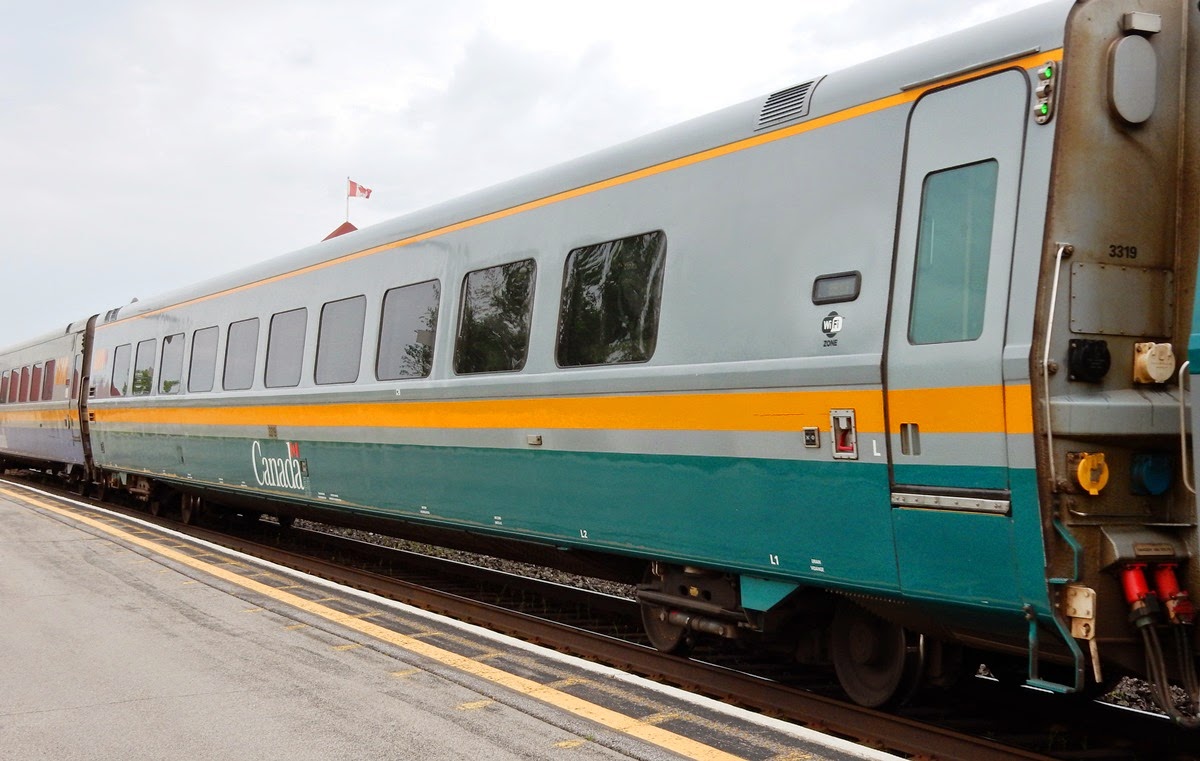Bear in mind that UPX only has 18 of the Sharyos, they are mechanically problematic, they are high platform, and the assembly line is torn down. The most likely candidate to buy them if they become available is SMART, but there's *still* no definitive date for Metrolinx to electrify the line allowing them to be replaced.
Just in discussion on exactly this point with a friend, and he writes:
[Are you sure that those train sets can be boarded by passengers from platforms which are essentially at track level? Building high-level platforms is dramatically easier if the operator also owns the ROW, as is the case with the UP Express (via Metrolinx), but not with VIA (at least not for any of the corridors you've mentioned). Also, keep in mind that VIA cannot acquire any new rolling stock without the approval and funding from its shareholder and that buying up a fleet which has been designed for a completely different client, region and service is not automatically a smart move, even if you manage to secure a deep discount from the initial price.]
UPDATE: Nippon Sharyo lays off 100 more workers in Illinois | Trains ...
trn.trains.com › News › News Wire
Jan 23, 2017 - 30, 2017, if
Nippon Sharyo is unable to deliver on the contract. ... in Japan, and has also produced equipment for
Sonoma-Marin Area Rail Transit ... previous layoffs in 2015 and 2016 to the bilevel cars' mechanical
problems.
SMART | Systemic Failure
https://systemicfailure.wordpress.com/tag/smart/
Dec 30, 2016 -
SMART blames its staffing
problems on the high-cost of living. ... Indiana, and on September 14 met with Cummins, carbuilder
Nippon Sharyo ...
SMART isn't in operation yet, but already has major engine problems ...
https://systemicfailure.wordpress.com/.../smart-isnt-in-operation-yet-but-already-has-...
Oct 15, 2016 - Back in 2009,
SMART came up with a bonehead plan to use ... and on September 14 met with Cummins, carbuilder
Nippon Sharyo and SCOA.
SMART train is on hold till 2017 - PressReader
https://www.pressreader.com/usa/san-francisco-chronicle-late.../282007556914774
Oct 15, 2016 -
SMART train is on hold till 2017.
Problems delay North Bay rail ... The manufacturer,
Nippon Sharyo of Japan, will begin replacing the engines ...
Cummins working with two companies over faulty engine reports
www.therepublic.com/.../cummins_working_with_two_companies_over_faulty_engine_...
Oct 21, 2016 - Cummins is working with two of its customers over engine
problems ... supplied for the Sonoma Marin Area Retail Transit District (
SMART) in California. ... with Cummins officials, train car builder
Nippon Sharyo and Sumitomo.
If VIA were to buy something to replace their already overhauled RDCs, it wouldn't be the Sharyo DMUs.
Edit to Add: Here's the lesson to be learned and for Transport Canada to get off their zorry azzes and do as the FRA is in the US, the very agency TC states they need to copy, until it comes to modernizing regulations: (The US is well behind the rest of the world, but well ahead of Canada)
SMART isn’t in operation yet, but already has major engine problems
October 15, 2016 by
Drunk Engineer
Back in 2009, SMART came up with a bonehead plan to use custom-design rolling stock — a decision heavily criticized in this blog. And here we are six years later, and they are still struggling to get
something working:
On September 7, 2016, SMART was notified by SCOA [Sumitomo Corporation of America] that the failure was due to an underlying design flaw in the engine’s crankshaft. Responding to this news, SMART’s Vehicle Maintenance Superintendent, supported by LTK vehicle engineers, travelled to the Cummins Engine facility in Seymour, Indiana, and on September 14 met with Cummins, carbuilder Nippon Sharyo and SCOA. At the meeting it was agreed that the engines would be rebuilt with a new crankshaft designed for the life of the engine, as soon as possible.
So now all the engines will need to be scrapped, and the train design re-tested. The SMART staff is now (very optimistically I think) saying the line won’t open until at least Spring 2017. The previous opening date was supposed to be the end 2016 (which had already been pushed back 2 years due to other issues).
Remember: the whole rationale for using custom FRA-compliant rolling stock was that it would take “too long” to get regulatory approval for off-the-shelf European DMUs.
https://systemicfailure.wordpress.c...on-yet-but-already-has-major-engine-problems/
















